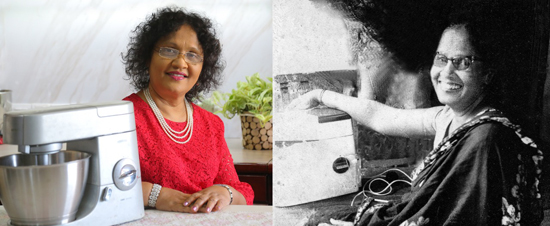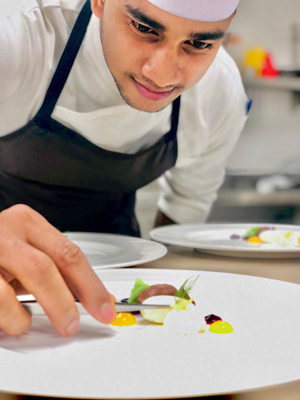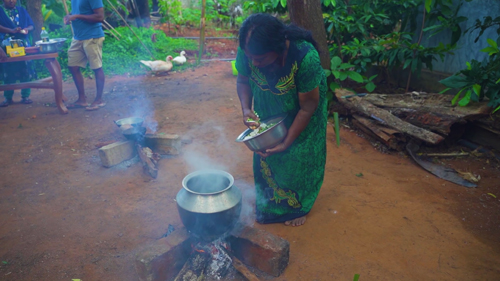Their recipe to success

Her Amma’s legacy: Anoma Wijetunga (left) of Anoma’s Kitchen and (right), her mother Agnes
A few years ago, Anoma Wijetunga wanted to conduct cooking classes but worried that no one would attend. While returning to Colombo by train after a trip, she broached the idea of uploading videos on the internet to her daughter. The next day, armed with her iPhone 6, they filmed a recipe for the most popular dish in their household: pol sambol. The video was sent to family for feedback – a critical family member who initially remarked that Anoma would have to attend public speaking and voice training lessons to make internet videos, acquiesced that her on-screen style was natural and welcoming. The video was uploaded in July 2016.
Soon Anoma and her daughter were filming and editing more videos, both learning as they went. As her daughter had to return overseas for her studies, Anoma began learning video editing. “Just think about it. There I was in my mid-fifties – and now you know my age – learning about video editing and iMovie through books and online,” she says.
Some 1,114 videos later, Anoma’s YouTube channel ‘Anoma’s Kitchen’ is so familiar on Sri Lankan YouTube she gets recognized even with a facemask. To date, she edits her own videos while her husband, a graphic designer and photographer, helps with shooting. Veering away from the short video aesthetic popularised by food channels such as Buzzfeed’s Tasty, where disembodied hands rapidly assemble a recipe without any accompanying narratives, as she wanted to maintain a personal connection with her audience – her recipes are instructional, detailed and offer step-by-step narration.
An aspect that comes through conversations with Anoma is the food legacy that her parents, and particularly her mother, Agnes de Silva, left – one that she tries to inculcate within her own family and through her videos that food offers a conduit for community, quality time and care. Another is the detail and planning poured into household meals and entertaining, visible in the recipes and tips featured on the channel. Anoma pauses our conversation to show her collection of recipe books and pages from one with years and years of menu plans with rich marginalia.

Tik Tok star: Charith N. Silva
Certain healthy recipes don’t bring in views and her digital growth has been slow in comparison to other Sri Lankan food bloggers but she remains unruffled. Her aim, then and now, she says is to teach cooking and to demystify homemade food for a younger generation.
“Gauging from feedback, I think I remain in people’s thoughts. Slow and steady works for me,” Anoma says.
Social media platforms such as YouTube and TikTok have seen an increase of food-related content from users based in Sri Lanka. Apè Amma posts instructional cooking recipes by a retired teacher clad in a signature pink coat and hat on YouTube and has garnered 419 million views to date. The ‘Traditional Me’ cooking channel features food videos filmed amidst highly stylized backdrops, instrumental music and pastoral village visuals from Dankotuwa that would not be out of place in a movie. With 1.31 million subscribers, it appeals to a specific gaze, depicting what is perceived as ‘pure’, rustic village life.
The ‘Yaarl Samayal’ YouTube channel begun as a virtual recipe book by Mathi Sivarajah to teach her family how to cook is a new entrant to this scene. Her son, Sivarathan, who also runs his own YouTube channel, had always nudged Mathi to document her recipes and share them online but it was only when she fell ill a few years ago and was hospitalized that she realized that filming her recipes would help her household learn how to cook, even in her absence. Since 2019, the channel has found a wider public niche, beyond the family.
“We never thought it would reach a wider audience like this. It is a true depiction of the food we cook at home,” says Shivaja Lambotharathan, Mathi’s daughter.
The videos narrated in Tamil, have a natural feel about them and are filmed and edited by Sivarathan. Although invisible from the frame as she is too shy to appear on camera, Mathi’s warm, lilting step-by-step narratives accompany recipes such as mutton curry, payaru sundal, adi koozh, tinned fish curry and more. The recipes are what the family eats on a regular basis and sometimes choose to film and therefore there is little scripting or planning, they explain. “This is the food a middle class family in Jaffna would cook,” says Mathi.
Sometimes everyday sounds in the neighbourhood punctuate the videos. “I feel homesick like I am in Jaffna listening to the dog bark and the crow sound. It is weirdly soothing and comforting to listen to that,” observes a comment under a video.
Mathi’s videos have attracted viewers from UK, Canada, France, India and Sri Lanka, keen to learn recipes from Jaffna. The comments range from recipe requests to Proustian memories and long reflections of homesickness and gratitude, offering a testament to the draw of Mathi’s simple narrative style and quality of cooking.
“You are a blessing to me amma. I found your channel when I was looking for aadi kool recipe. My mom is in another continent and my mother-in-law passed away. I never learnt cooking growing up and when I want to make authentic dishes I have always felt lost. Thanks to you I made the aadi kool yesterday and the whole family loved it. I will be making idli sambal today,” reads one comment.
As Sivarathan, a student at University of Kelaniya, had to study from home due to COVID-19, they have been able to film, edit and upload more videos in the last year. The next recipe Mathi hopes to shoot is hoppers. For now, they plan to continue highlighting traditional Jaffna dishes and techniques. “Everyone should watch it and learn to cook,” Mathi smiles.
Meanwhile, documenting recipes on TikTok, YouTube and Instagram has brought internet fame for 25-year-old Charith N. Silva, the face behind Wild Cookbook.

Food we cook at home: Mathi Sivarajah making Jaffna style Odiyal Kool in her garden
Charith’s cooking videos on TikTok brim with energy and utilize viral songs, popular videography techniques and food trends. Wild Cookbook has 1.2 million followers on TikTok and all recipes are in response to comments by fans, explains Charith. A jalebi recipe shot in response to a user comment shows a dramatic, slow motion shot of flour being poured into a bowl, a whisk being tossed in the air by a smiling Charith, close-ups of saffron coils of jalebi cooking in bubbling oil and his signature, dramatic flourish with his Chef Knife (a gift from the Executive Chef he worked with) – all in sync with the viral pop song Jalebi Baby by Tesher and Jason Derulo.
For Charith, COVID-19 brought a considerable shift in his life. With a family background in the hospitality industry, Charith began working as a chef in 2015, learning on the job and specializing and gaining experience in pastry and baking. “A chef’s life is a different life. Sometimes we work for 24 – 48 hours straight. We work during holidays and on the days when everyone else rests,” says Charith, who lives in Galle. “Everything changed because of COVID.”
After contracting COVID-19, Charith had to rest for one and a half months. Although he had started his YouTube channel and TikTok account much earlier, the videos made in-between full-time work were sporadic and did not bring in many views. The pause brought about by COVID gave Charith an opportunity to produce more videos and experiment heavily with style. He tried music, ASMR (videos designed to stimulate something called autonomous sensory meridian response through soft, repetitive sounds) and finally B-roll techniques which feature secondary footage. His slow motion, action-packed B-roll footage, which dramatically emphasized the cooking process, proved to be a hit and his following on TikTok surged. With a team of three to shoot, edit and produce videos, Charith decided to become a full-time food blogger earlier this year.
“We’ve grown our social media following with a lot of difficulty. If I had gone back to full-time work, I would have lost this audience. Social media audiences won’t wait for you to finish your job and come and make videos,” he explains emphasizing the need to produce regular content.
The Wild Cookbook team now uploads 20 – 25 videos a month on its social media platforms, with an emphasis on TikTok. Each video takes about three days to complete and is filmed in an external, private location while recipes are often rapidly tested and shot in one take. Wild Cookbook’s focus is decidedly international featuring recipes from ramen, roti and jollof rice to faluda, lavariya and tanghulu and plans are to work on more international recipes.
“Behind a short one-minute video, there is a lot of work with videography and edits and a lot of costs. It’s a long process but we try and do it well. There may be people who are better than me but who cannot pursue this kind of work because of rising costs and other factors. Everything I have received has been through people on social media, through their engagement and comments. I am very grateful and I hope they will please stay on,” says Charith.
Searching for an ideal partner? Find your soul mate on Hitad.lk, Sri Lanka's favourite marriage proposals page. With Hitad.lk matrimonial advertisements you have access to thousands of ads from potential suitors who are looking for someone just like you.


